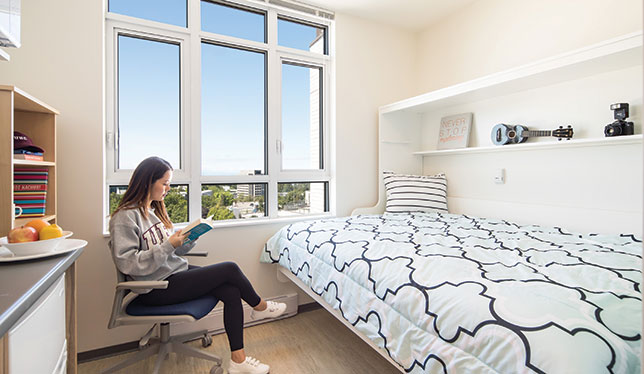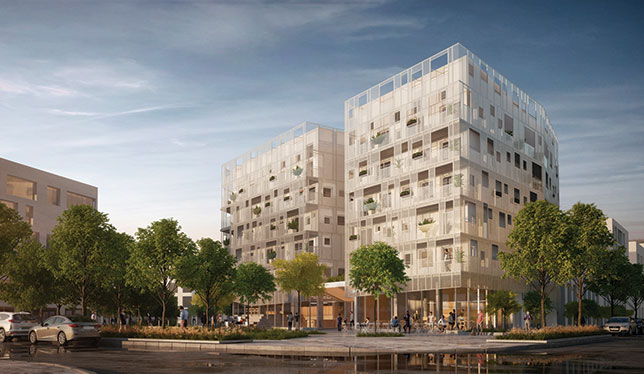Yvonne Ko’s room on the University of British Columbia’s campus in Vancouver is almost small enough that she can reach out and touch the walls on each side. The 120-square-foot space includes a bathroom, a fold-down bed that doubles as a desk, and a micro-kitchen.
That’s fine by her. Ms. Ko, a film studies major originally from Toronto, is willing to trade off the smallness of what UBC calls its “nano-suites” for a lot of other things: only $750 a month for rent; a quick walk to all her classes and other university activities; and a building that has game rooms, lounges, a private garden that overlooks the campus, and a laundry room in the middle of all that (instead of being stuck in a basement somewhere).
“In a student residence, I felt more support. You have access to so many amenities,” says Ms. Ko. She showed off the view of UBC’s clock tower and new student gym from her window in the two-year-old Exchange Residence, as she talked about strategies for storing her belongings in a space that’s smaller than some hotel rooms. (Lots of creative piling, plus plastic tote boxes.)
Ms. Ko isn’t the only student who is enthusiastic about this new form of housing. There are dozens on a waitlist for one of these 71 apartments, says Andrew Parr, UBC’s vice-president in charge of housing and community services. Post-occupancy surveys show that students have reacted positively to the small spaces, which went through an intensive design process in advance to make sure they provided what students wanted most. “One of the features that makes it work is the bed/desk combo,” he says.

More nano-suites are being planned at UBC, and Ryerson University is looking to emulate them in its next student-residence project. They’re just one of the many solutions that universities and colleges across Canada are looking at as they cope with a vise-like squeeze on places their prospective students can live – an aspect of postsecondary life that can weigh as heavily as grades, tuition or exams.
Universities and even some colleges are energetically exploring ways to build more student housing of all kinds, either by themselves or in partnership with private developers. Some are looking to use their existing land more creatively – for example, by building student housing right on top of new academic buildings – as Ryerson is doing. A few have even bought and converted hotels.
UBC is looking to increase its student beds from the current 12,000, the most of any university in Canada, to 17,300 by 2030. The University
of Toronto has developed a specialized plan to provide more housing in any future developments by leveraging its considerable land assets. The aim is to significantly increase the current 8,400 beds, especially at its suburban campuses. The latest of many planned projects just broke ground this past December. “Four new residence projects currently underway aim to add more than 1,000 beds at the St. George campus and a further 750 new beds at the Scarborough campus in the next few years. New residences are also planned for the Mississauga campus,” says Josh Mitchell, the university’s managing director of real estate. “Under its 4 Corners Real Estate strategy, the university aims to add just over 4,000 units of university housing for students, faculty and staff over the next 10 to 15 years on its downtown campus alone to address high demand.”

Even at Ryerson, an institution that has typically catered more to local students than to those from other parts Canada or other countries, there’s pressure to provide more housing. “We continue to see an increase of students applying to live in residence,” says Valerie Bruce, the director of student housing and community care at Ryerson. Until a few years ago, the university only had about 850 beds available for students. It now has 1,150, and more are in the works.
There will be pressure on many postsecondary institutions to do more. Although reliable statistics are hard to come by on how much housing affects student choices about where to go to school, intuitively many feel there’s a connection. As well, the issue of student housing goes far beyond these institutions. It affects whole cities and many other residents living in them.
The private housing industry – along with at least one innovative nonprofit in Quebec – is also getting more involved, after noticing big gaps in the Canadian market. Those gaps became very evident in the fall of 2021. Tens of thousands of students returned to in-person learning and discovered that it was tougher than ever to find a place to live, and universities were reducing their residence occupancies as part of COVID-19 precautions. From Halifax to Montreal, Toronto to Edmonton, and especially Vancouver and Victoria, there was a cascade of news stories documenting a start to the academic year in which students faced one of the most pronounced housing crunches on record. “This is something we are hearing more and more about in the last couple of years,” says Bipin Kumar, the international student representative and deputy chair for the national graduate students’ office at the Canadian Federation of Students (CFS).
A country-wide crisis
It may feel like a local crisis to each city and town with a regular influx of students every year. But the numbers show that it’s a national one, related to a few basic statistics that underlie all the individual and regional stories. The numbers that matter are, first, how much universities have come to rely on tuition and, by extension, high-paying international students in order to meet their budgets, as government funding has lagged behind costs. The second is what that has meant in terms of the numbers of international students that Canadian university cities have been trying to absorb. A 2020 Statistics Canada report outlined those two driving forces clearly. “Previous analysis has shown that the reliance of universities on tuition as a revenue source has grown over the past decade and that international students, who pay substantially higher tuition than domestic students, are an important element of this growth, contributing an estimated 40 per cent of all tuition fees and accounting for almost $4 billion in annual revenue for Canadian universities in 2018/2019,” it says.
The report, along with previous ones from StatsCan, show that the number of international students in some provinces tripled in the decade since the 2008/09 academic year, and almost doubled from 2015 to 2020. They now account for almost all of the enrolment growth happening at Canadian universities. International student enrollment in Ontario grew from about 96,000 to almost 193,000 in those five years. In B.C., the province with the next-highest increase, it went from 45,000 to almost 71,000.
“The census underestimates students and doesn’t allow for a very clear identification of student housing needs. Students are invisible in housing data.”
Many of those students ended up going to cities that already had noticeable problems with low vacancy rates and housing shortages. The rising influx can have a big impact on a city through a “studentification,” as researchers have labelled it, of key neighbourhoods. “Students look for modestly priced housing, so it displaces lower-income folks,” says housing consultant Steve Pomeroy, who has done studies for universities on the economics of student housing and the need for additional supply.
Unlike their domestic counterparts, very few international students have families they can bunk with while going to school. Data from Utile, a Quebec non-profit that researches student-housing issues, show that 60 to 70 per cent of Canadian students end up being tenants. But among international students, it’s 100 per cent. Mr. Kumar, from CFS, says he doesn’t believe that international students have made the housing problems that much worse than they already were in several cities that had extremely low vacancy rates. But their difficulties in finding apartments are much more acute, because they are often asked by landlords to provide local references or income guarantees that are more of a hurdle for them than for students who are Canadian residents.
Missing data
Even though Canada has become increasingly obsessed with housing issues, somehow student housing has gone under the radar in spite of the undercurrents reshaping the issue, says Utile co-founder and executive director Laurent Levesque. “The census underestimates students and doesn’t allow for a very clear identification of student housing needs. Students are invisible in housing data,” he says. “So it’s been hard to advocate for an issue when there has been no hard student information.”
That’s changing, as more people start to pay attention to the issue. A Canadian Imperial Bank of Commerce report in 2019 said the Canada Mortgage and Housing Corporation has consistently miscalculated the state of student housing – missing the need for 300,000 more homes to keep up with student demand. The small but growing group of companies looking at private investment in student housing makes the same point. “There is an acute shortage of student housing across Canada,” says Derek Lobo, the CEO of SVN Rock Advisors, a company that specializes in marrying private developers of student housing with institutions that need more of it.
There are only 120,000 student beds on campuses across the country and only about 40,000 purpose-built student beds off-campus (20,000 of them in Kitchener-Waterloo, Ont.), Mr. Lobo says; a far lower proportion than other countries that are popular with international students. His company’s numbers are matched by those at Alignvest Student Housing REIT, which has found that there are only enough student beds in Canada for about three per cent of the total student population, compared to the 20 or 30 per cent in the United Kingdom and the United States. According to data from Utile, about 1.3 million of Canada’s 1.5 million students are in the private rental market.
“What we’ve seen in Quebec and other places was that higher education was forced to step away from housing because of the other financial constraints. And housing agencies just forgot about student demand.”
Both Mr. Lobo and Trish MacPherson, a partner at Alignvest, say the international-student phenomenon doesn’t just impact larger cities. “Most people think that international students go to big universities. But they go to where they can get in,” says Mr. Lobo. That’s why in Prince Edward Island, for example, almost 30 per cent of all students are international and they’re feeling the housing pinch too. It’s also why Alignvest is looking at building in markets like Hamilton, Ont., and Oshawa, Ont., not just Toronto.
Part of the problem is that there hasn’t been a lot of activity by private developers of student housing. “It’s a sector that is still in its infancy in Canada,” says Brian Flood, a vice-president with Cushman & Wakefield, which just produced a report on the subject. “But the level of investor interest in the sector is very strong.”
They have come to the realization quickly, as have many other analysts, that student housing is the one type of low-cost housing that can be profitable. While housing groups and developers have agreed that it’s pretty near impossible to build low-cost housing for the general public without some kind of subsidy, the equation is different for student housing.
Students, knowing they are staying a few years at most, are willing to live with less space than someone looking to rent an apartment for perhaps the rest of their life. As well, rents in student housing can be adjusted upwards regularly because tenants move out on a regular basis. Again, that’s a contrast to long-term resident housing, since rent controls in many provinces cap how much of an increase an existing tenant can be asked to pay each year.
The Cushman & Wakefield report suggests that student housing can have strong profit potential, with expenses averaging about 35 per cent of a potential revenue stream. “[It can] provide higher potential rental growth as units turn over more frequently. Rental rates achieved at student residence complexes also often exceed market rents for similar traditional apartment units,” the report concludes.
For-profit vs. non-profit
But Mr. Lobo says universities need to be careful before they plunge willynilly into building hundreds of beds. They need to understand where their students are coming from and what their tastes might be. “Student housing is not a programmatic business. It’s a boutique business,” he advises. Don’t build if the vast majority of students are local commuters, coming from their parents’ homes. Make sure you have access to the one thing students value most – a location close to campus. “We say you’ve got to be able to walk to school with less than three songs on your iPhone,” says Alignvest’s Ms. MacPherson. Amenities are also a big deal in student housing, so pay attention to the types of students you are catering to. If there are a lot of design students, provide good lighting and access to studio space. Most of all, be aware that the trend is away from dorms, the six-bedrooms-around-a-common-living-space format, away from even two-person residence rooms with the toilet and shower down the hall. Instead, there’s a steady move towards one bathroom per bedroom.

Mr. Lobo’s word of the day to universities is not to try to do everything themselves. “You’re not going to solve your problem without help from the private sector.”
But Utile, the Quebec non-profit, makes a different argument. Because student housing can actually break even, it’s something that universities and non-profits should be taking on, rather than just private developers, says Mr. Levesque. “This model doesn’t require as much funding as traditional social housing. You can develop affordable housing for free if you get university land,” he says.
The non-profit, which was started in 2012 by a group of students concerned about the growing student-housing problems in Montreal, completed its first pilot development in 2020. The $18 million project was paid for in part by leveraging a contribution from the Concordia University student union, which was funded through student fees. Mr. Levesque is the first to admit it wasn’t easy, because the concept and the group implementing it – former students from various Quebec universities – were new to the industry. But now, he says, the banks are on board and Utile gets considerable support from Canada Mortgage and Housing Corporation programs. It provided $3 million in 2019 to support Utile’s early efforts and, in June 2021, announced another $20 million as a loan to the group.
Utile’s Woodnote building in Montreal has 90 apartments that can house 144 students, who pay between 10 and 30 per cent below the market rate. Studios that are 300 square feet go for $740 a month. The group now has a second project underway in Montreal’s Rosemont neighbourhood, and it has bought land in Trois Rivieres, Que., and Quebec City. It’s also fielding calls from smaller communities that are also dealing with shortages of student housing.
“What we’ve seen in Quebec and other places was that higher education was forced to step away from housing because of the other financial constraints. And housing agencies just forgot about student demand,” says Mr. Levesque. “But once we demonstrated that it’s possible, the floodgates have opened.”

I think you are conflating two things that are unrelated. International students have no detriment to the housing situation in Canada, they are a victim of it. The real problem, I believe, lay in Canadians who are more than happy to “cash in” on their real estate revenue which has driven prices and availability into an impossible situation. We need to consider what we want our communities to be like to live in for our students (domestic or international), our families and our future generations rather than taking the $1 Million dollars and none of the responsibility for what we have caused.